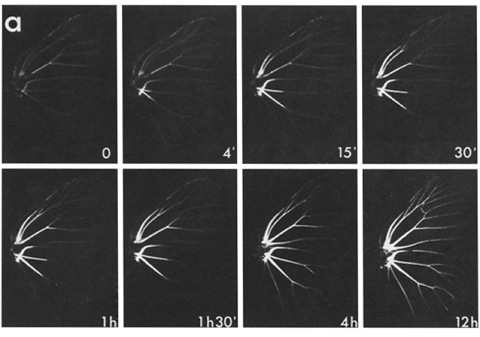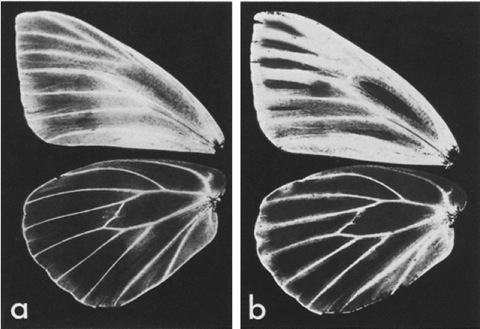Wasserthal, L.T. (1983): Haemolymph flows in the wings of Pierid butterflies visualized by vital staining (Insecta, Lepidoptera). - Zoomorphology 103: 177-192.
The flow of stained haemolymph was photographed in the wings of resting Pieris rapae, Pieris brassicae, and Gonepteryx rhamni under UV-radiation at definite intervals after abdominal application of fluorescent tetracycline. There is no circular route in the wing. All wing veins are supplied with stained haemolymph from their own bases without preference to single veins. In freely resting Pieris with intact wings, most veins are completely stained after 20 min. The staining pattern supports the existence of an oscillating haemolymph supply mechanism in the wing veins and shows that the cross vein and encircling sinus are not essential in the supply of the longitudinal veins. Inflow of stained haemolymph into the wing membrane begins about I h after application and is generally completed within 12 h in Pieris. The wing membrane is supplied with fluid by diffusion and - especially under low relative humidity - additionally by haemolymph substitution of evaporated water. This mechanism is associated with the disadvantages of water loss and probably salt withdrawal from the body. The puddling behaviour of butterflies might help in restoring these postulated deficits. It is hypothesized that haemolymph substitution of water evaporated from the wing membrane is a preadaptation for accumulation of defensive toxins and pheromones in the wing membranes, especially in diurnal and basking Lepidoptera. The veinal system of 5-day-old young summer specimens of Gonepteryx stains more intensely than that of 4-5-month-old specimens just before entering hibernation. The transition of stained haemolymph from vein to membrane is reduced in this species, probably as an adaptation for water retention during diapauses.

Penetration of stained haemolymph independently into all wing veins, demonstrating a tidal flow (Gonepteryx rhamni)
The stained haemolymph diffuses slowly from the veins into the wing membrane after 20 hours; (a) under high humidity, (b) under low humidity. (Pieris brassicae).

